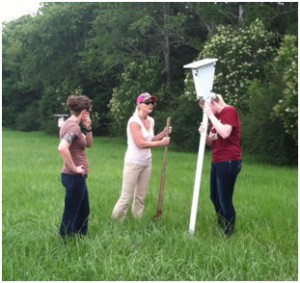Spring is a dynamic time for wildlife. If you enjoy watching nature, now is a fantastic time to get outdoors to see some interesting activity. March is also one of the best times of year to do some active management on your property to enhance the habitat you provide for wildlife.

Purple martins select nest sites during February-March in the Panhandle, so now is your last chance to make martin housing available. Photo by Sarah Friedl.
Because of its position just north of the Gulf of Mexico, Florida is the first landmass where many exhausted birds can rest after migrating northward to the U.S. from South and Central America. The strenuous northward migration is now underway for many species of birds. That means this is one of the most interesting times of year to visit your local natural area with a pair of binoculars. A trip to St. Marks National Wildlife Refuge or your nearby State Park or Wildlife Management Area could result in a glimpse of several migratory species that are rarely seen in the area.
Purple martin scouts began their migration from South America to the Panhandle nearly four weeks ago. If you have purple martin housing and have not yet cleaned out last year’s nesting material, now is your last chance to do this. Wash out your housing with soap and water. If you take your martin housing indoors during the fall and winter to protect it from harsh weather or if you plug the entrances to prevent use by other species, don’t wait any longer to make your housing available to martins or you’ll miss out on attracting them this year. Older martins remain extremely faithful to the exact same nesting site, so will want to return to the housing you provided them last year. In contrast, yearling martins that hatched last summer tend to return to the same area they were born in Florida about 4-6 weeks later than the older scouts. These yearling birds are generally the ones who adopt new housing and start new colonies. Therefore, this week is the ideal time to put up new purple martin housing in the Panhandle.
Eastern bluebirds are resident all year round, but March is when they begin nesting in the Panhandle. Because bluebirds have a habit of nesting several times each year, it is possible that birds will adopt new houses erected later in the spring. However, the sooner you make new bluebird houses available, the greater the chances you’ll attract nesting birds. When deciding where to locate new bluebird houses, remember that bluebirds are territorial and will not let another bluebird nest within ~100 yards of a nest site they’ve already chosen.

Bluebirds nest several times each year, so you can install a new bluebird house anytime during the spring, although February-March is ideal. Photo by Holly Ober.
For more information on attracting birds, check out this article on Purple Martins or this one on Cavity Nesting Birds. Or contact your county’s UF/IFAS Extension Office.
 Author: Holly Ober – holly.ober@ufl.edu
Author: Holly Ober – holly.ober@ufl.edu
I am an Associate Professor and Extension Specialist in the Department of Wildlife Ecology and Conservation. My research covers wildlife ecology, habitat management, and identifying creative ways to cope with nuisance wildlife.
Posted: March 22, 2014
Category: Natural Resources, Wildlife
Tags: Birds, Consider, Ideal, March, Panhandle Outdoors, Time, Wild

